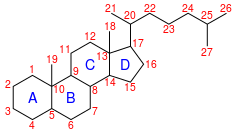Sterane (cyclopentanoperhydrophenanthrenes) compounds are a class of tetracyclic compounds derived from steroids or sterols via diagenetic and catagenetic degradation and saturation. Steranes have an androstane skeleton with a side chain at carbon C-17. The sterane structure constitutes the core of all sterols. Steranes are sometimes used as biomarkers for the presence of eukaryotic cells.[1]
Steranes may be rearranged to diasteranes during diagenesis (C-27 to C-30, rearrangement at C-18 and C-19, no R at C-24). Oils from clastic source rocks tend to be rich in diasteranes.
Cholesterol and its derivatives (such as progesterone, aldosterone, cortisol, and testosterone), are common examples of compounds with the cyclopentanoperhydrophenanthrene nucleus.
https://en.wikipedia.org/wiki/Sterane
Jump to navigation Jump to search

| |
 IUPAC numbering[1]
| |
| Names | |
|---|---|
| IUPAC name
Cholestane
| |
| Preferred IUPAC name
(1R,3aS,3bR,9aS,9bS,11aR)-9a,11a-Dimethyl-1-[(2R)-6-methylheptan-2-yl]hexadecahydro-1H-cyclopenta[a]phenanthrene | |
| Identifiers | |
| |
3D model (JSmol)
|
|
| ChEBI | |
| ChemSpider | |
| ECHA InfoCard | 100.035.496 |
PubChem CID
|
|
| UNII |
|
CompTox Dashboard (EPA)
|
|
| Properties | |
|---|---|
| C27H48 | |
| Molar mass | 372.681 g·mol−1 |
| Density | 0.911 g/ml |
Except where otherwise noted, data are given for materials in their standard state (at 25 °C [77 °F], 100 kPa).
| |
Cholestane is a saturated tetracyclic triterpene. This 27-carbon biomarker is produced by diagenesis of cholesterol and is one of the most abundant biomarkers in the rock record.[2] Presence of cholestane, its derivatives and related chemical compounds in environmental samples is commonly interpreted as an indicator of animal life and/or traces of O2, as animals are known for exclusively producing cholesterol, and thus has been used to draw evolutionary relationships between ancient organisms of unknown phylogenetic origin and modern metazoan taxa.[3] Cholesterol is made in low abundance by other organisms (e.g., rhodophytes, land plants), but because these other organisms produce a variety of sterols it cannot be used as a conclusive indicator of any one taxon.[4][5] It is often found in analysis of organic compounds in petroleum.
https://en.wikipedia.org/wiki/Cholestane

No comments:
Post a Comment